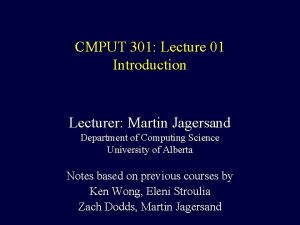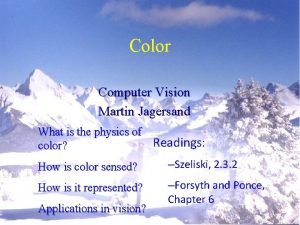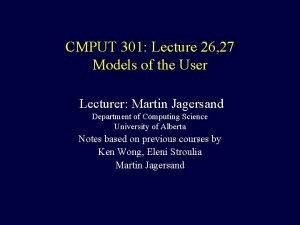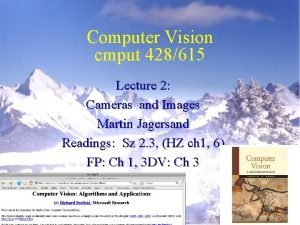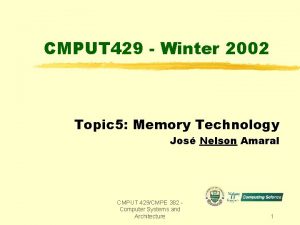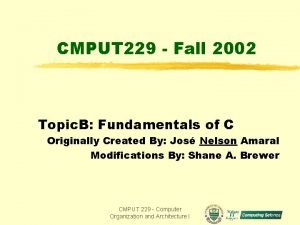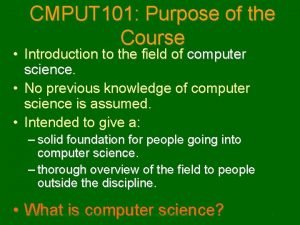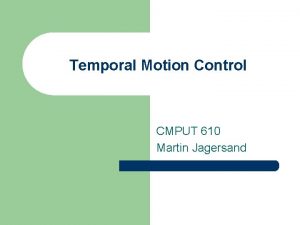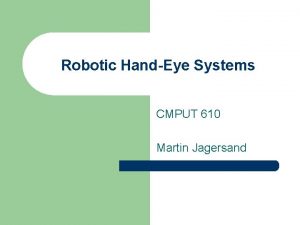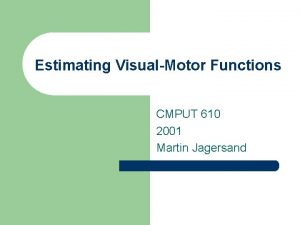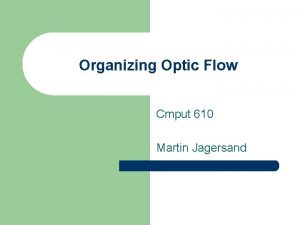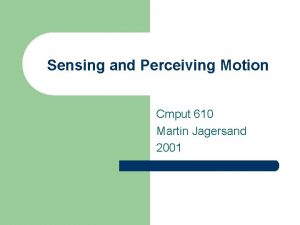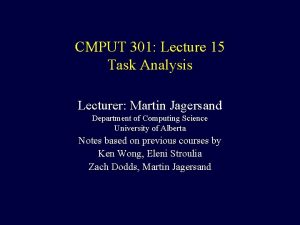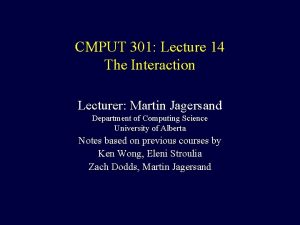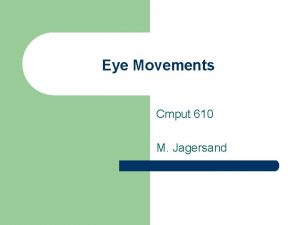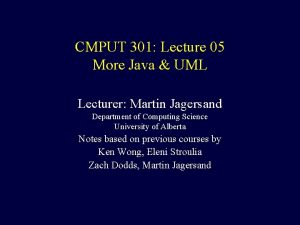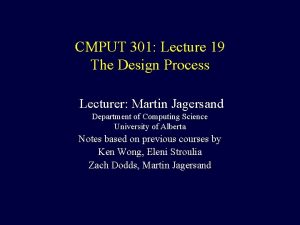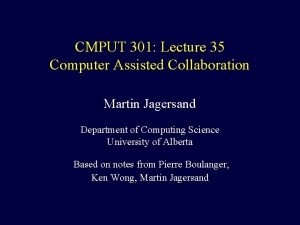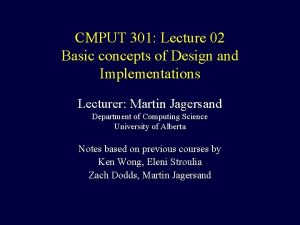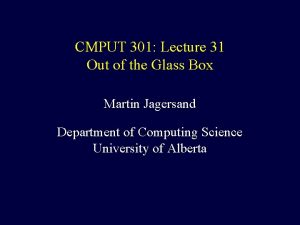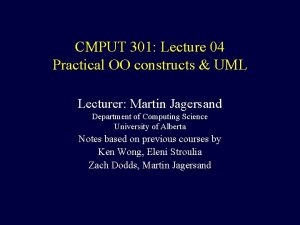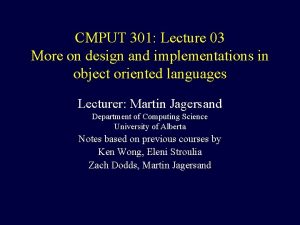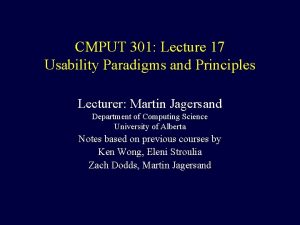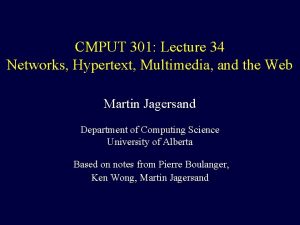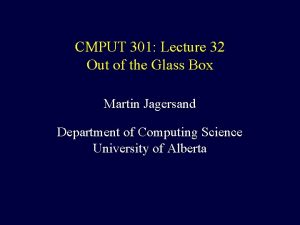CMPUT 301 Lecture 01 Introduction Lecturer Martin Jagersand


























- Slides: 26

CMPUT 301: Lecture 01 Introduction Lecturer: Martin Jagersand Department of Computing Science University of Alberta Notes based on previous courses by Ken Wong, Eleni Stroulia Zach Dodds, Martin Jagersand

HCI and program design • Why worry about the user? 1. People “more expensive” than machines 2. Errors may be unacceptable 3. Can’t sell unattractive and hard to learn SW • Design 1. For the user: Useful, correct, complete, efficient 2. For the programmer: Portable, changeable, extensible, reusable 2

Course content: How to do User Interfaces • Object Oriented SW eng: – Learn the programming skills • The human: – What perceptual skills support what interaction? • Design and evaluation: – Task analysis, usability, evaluation 3

Example: Interaction and interfaces: • The past? – Text based interaction: If A then end 4

The present: Direct manipulation: • xfig drawing program Icons afford use • Results visible • Direct spatial actionresult mapping matlab drawing: line([10, 20], [30, 85]); patch([35, 22], [15, 35], C); % C complex structure text(70, 30, 'Kalle'); % Potentially add font, size, etc 5

The future? Vision and Touch UI • Observe and Interpret Physical Interactions • Make Machines work with Humans • Soon most appliances will have embedded computers 6

Motivation • Clint Eastwood classification: – the good – the bad – the ugly 7

Motivation • The good: 8

Motivation • The bad: 9

Motivation • The ugly: 10

Question • What are some other examples? • In the real world? 11

Why Design? • “Despite the enormous outward success of personal computers, the daily experience of using computers far too often is still fraught with difficulty, pain, and barriers for most people. ” • … 12

Why Design? • “The lack of usability of software and the poor design of programs are the secret shame of the industry. ” — Mitch Kapor 13

Why Design? • There’s more to developing software than just making it work correctly. 14

Why Design? 15

Software Design • User perspective: – meets needs – increase user satisfaction – reduce frustration – increase productivity – reduce errors – easy to learn – easy to use 16

Software Design • Developer perspective: – manage complexity – reduce maintenance and support costs – increase quality – reduce defects – increase reuse – reduce time-to-market 17

Software Design • Selected goals: – bridging users and technology effectively – marry art and science – evolutionary development (design, implement, evaluate) – integrate expertise across disciplines 18

Multiple Disciplines • • industrial design graphic design architecture ergonomics cognitive psychology sociology anthropology ethics • • software engineering computer science visualization experimentation intellectual property arts business … 19

Software Design • • • Think about the user. Focus on goals and tasks. Try it out on the users. Involve the users. Iterate. 20

Book: “Human-Computer Interaction” by Alan Dix, Janet Finlay, Gregory Abowd, and Russell Beale, Prentice-Hall, 1998 http: //www. hcibook. com/hcibook/ 21

Instructor: Martin Jagersand • Office: Athabasca Hall 401 • Office Hours: By appointment • E-mail: jag@ugrad. cs. ualberta. ca • Phone: 780 492 5496 22

Staying in Touch • • • WWW page: http: //ugweb. cs. ualberta. ca/~c 301/ Newsgroup: ualberta. courses. cmput. 301 Emails: 1. Your section TA, e. g. ayman, trysi etc… 2. jag@ugrad. cs. ualberta. ca 23

Project • Complex – Components – Integration (early!) • Vague – Talk to users – Evolution • Team effort – Hold regular meetings – Assign tasks – Peer reviews 24

Grading • • Assignments: 15% Midterm Exam: 15% Project Parts: 40% Final Exam: 30% Note: All assignments and project parts are due on a Monday at 12 noon. The TAs will explain the submission process in the labs. Late submissions will not be accepted. 25

End • What did I learn today? • What questions do I still have? 26
 Lecturer's name or lecturer name
Lecturer's name or lecturer name Cmput 412
Cmput 412 Martin jagersand
Martin jagersand Martin jagersand
Martin jagersand Martin jagersand
Martin jagersand Cmput 301
Cmput 301 01:640:244 lecture notes - lecture 15: plat, idah, farad
01:640:244 lecture notes - lecture 15: plat, idah, farad Physician associate lecturer
Physician associate lecturer Spe distinguished lecturer
Spe distinguished lecturer Good afternoon teacher and my friend
Good afternoon teacher and my friend Photography lecturer
Photography lecturer Lecturer in charge
Lecturer in charge Designation lecturer
Designation lecturer Designation of lecturer
Designation of lecturer Why himalayan rivers are pernnial in nature
Why himalayan rivers are pernnial in nature Lecturer name
Lecturer name Pearson lecturer resources
Pearson lecturer resources Spe distinguished lecturer
Spe distinguished lecturer Lector vs lecturer
Lector vs lecturer Lecturer in charge
Lecturer in charge Cfa lecturer handbook
Cfa lecturer handbook Lecturer asad ali
Lecturer asad ali Cmput 274
Cmput 274 Cmput 367
Cmput 367 Cmput 382
Cmput 382 Cmput 229
Cmput 229 Cmput 101
Cmput 101


